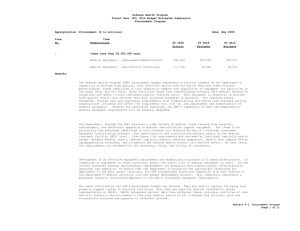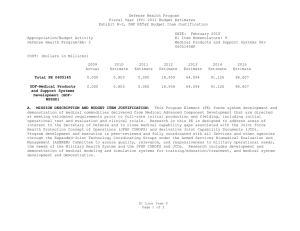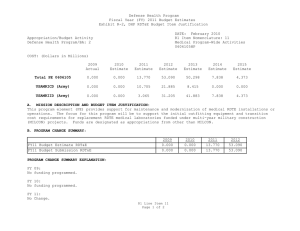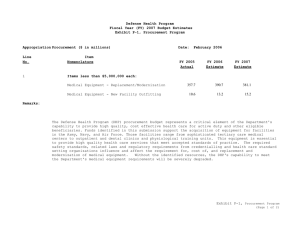DEFENSE HEALTH PROGRAM
advertisement
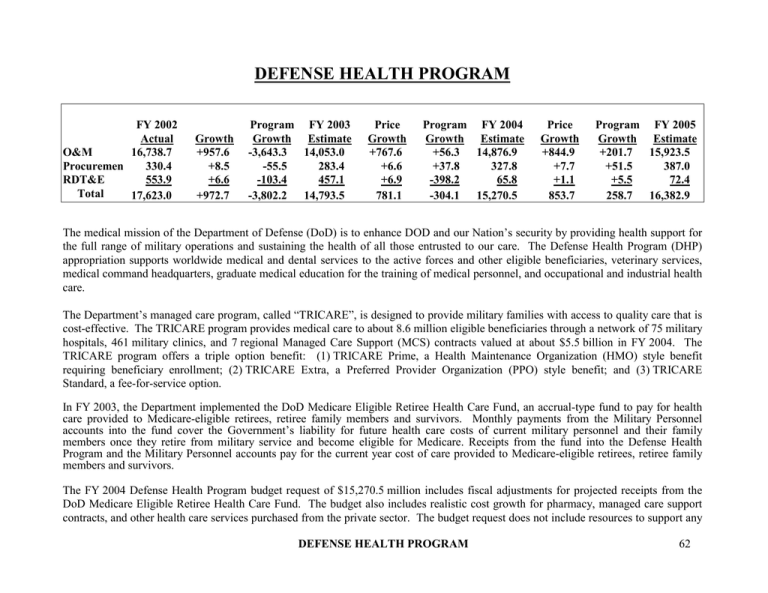
DEFENSE HEALTH PROGRAM FY 2002 Actual O&M 16,738.7 Procuremen 330.4 RDT&E 553.9 Total 17,623.0 Growth +957.6 +8.5 +6.6 +972.7 Program FY 2003 Growth Estimate -3,643.3 14,053.0 -55.5 283.4 -103.4 457.1 -3,802.2 14,793.5 Price Growth +767.6 +6.6 +6.9 781.1 Program FY 2004 Growth Estimate +56.3 14,876.9 +37.8 327.8 -398.2 65.8 -304.1 15,270.5 Price Growth +844.9 +7.7 +1.1 853.7 Program FY 2005 Growth Estimate +201.7 15,923.5 387.0 +51.5 +5.5 72.4 258.7 16,382.9 The medical mission of the Department of Defense (DoD) is to enhance DOD and our Nation’s security by providing health support for the full range of military operations and sustaining the health of all those entrusted to our care. The Defense Health Program (DHP) appropriation supports worldwide medical and dental services to the active forces and other eligible beneficiaries, veterinary services, medical command headquarters, graduate medical education for the training of medical personnel, and occupational and industrial health care. The Department’s managed care program, called “TRICARE”, is designed to provide military families with access to quality care that is cost-effective. The TRICARE program provides medical care to about 8.6 million eligible beneficiaries through a network of 75 military hospitals, 461 military clinics, and 7 regional Managed Care Support (MCS) contracts valued at about $5.5 billion in FY 2004. The TRICARE program offers a triple option benefit: (1) TRICARE Prime, a Health Maintenance Organization (HMO) style benefit requiring beneficiary enrollment; (2) TRICARE Extra, a Preferred Provider Organization (PPO) style benefit; and (3) TRICARE Standard, a fee-for-service option. In FY 2003, the Department implemented the DoD Medicare Eligible Retiree Health Care Fund, an accrual-type fund to pay for health care provided to Medicare-eligible retirees, retiree family members and survivors. Monthly payments from the Military Personnel accounts into the fund cover the Government’s liability for future health care costs of current military personnel and their family members once they retire from military service and become eligible for Medicare. Receipts from the fund into the Defense Health Program and the Military Personnel accounts pay for the current year cost of care provided to Medicare-eligible retirees, retiree family members and survivors. The FY 2004 Defense Health Program budget request of $15,270.5 million includes fiscal adjustments for projected receipts from the DoD Medicare Eligible Retiree Health Care Fund. The budget also includes realistic cost growth for pharmacy, managed care support contracts, and other health care services purchased from the private sector. The budget request does not include resources to support any DEFENSE HEALTH PROGRAM 62 DEFENSE HEALTH PROGRAM increased Global War on Terrorism requirements. The FY 2004 budget request assumes TRICARE prime enrollment fees and co payments will be indexed to OMB established inflation rates. Operation & Maintenance Program In-House Care Private Sector Care CHS Information Management Management Activities Education and Training Base Operations Total* FY 2002 Actual 4,386.3 8,466.8 950.9 904.7 367.2 384.8 1,278.0 16,738.7 * Totals may not add due to rounding Price Growth +269.6 +627.1 +17.9 +11.8 +5.4 +11.3 +14.5 +957.6 Program Growth -794.2 -2,200.8 -124.4 -177.9 -126.2 -11.8 -208.0 -3,643.3 ($ in Millions) FY 2003 Price Estimate Growth 3,861.7 +218.0 6,893.1 +486.7 844.4 +18.0 738.5 +11.9 246.4 +4.6 384.3 +11.4 1,084.5 +17.1 14,053.0 +767.6 Program FY 2004 Growth Estimate 25.3 4,105.0 41.2 7,421.0 862.4 -29.3 721.1 -11.5 239.5 -10.4 385.3 +41.1 1,142.7 +56.3 14,876.9 Price Growth +246.0 +524.2 +20.6 +12.7 +4.9 +12.9 +24.1 845.5 Program FY 2005 Growth Estimate +178.3 4,529.3 -65.3 7,879.9 +36.3 919.3 +53.6 787.4 +.6 245.0 -2.8 395.4 +0.3 1,167.1 201.1 15,923.5 Program/Price Growth The FY 2004 DHP O&M budget request of $14,876.9 million reflects a net increase of $823.9 million above the FY 2003 funding level which includes price growth of $767.6 million and a net program increase of $56.3 million. In-House Care The DHP In-House Care provides for the delivery of care in MTF’s worldwide. The program includes care in medical centers, station hospitals, clinics, and dental care activities. The FY 2004 In-House Care budget estimate of $4,105.0 million increases by $243.3 million above the FY 2003 funding level. This increase includes price growth of $213.3 million; foreign currency fluctuation of $4.7 million; and a net program increase of $25.3 million. The net $25.3 million program growth is primarily composed of increases for: $59.4 million for pharmacy program growth above inflation due to increased utilization and the entry of new drugs into the market place $24.7 million increased requirement for appropriated funds to pay for health care costs as the result of revised level of effort reimbursement from the accrual fund; $12.6 million increase due to reversal of one time FY 2003 Congressional reductions; $4.4 million transferred from Private Sector Care to offset lost revenue at the MTF’s due to elimination of copays for active duty family members; and DEFENSE HEALTH PROGRAM 63 DEFENSE HEALTH PROGRAM $1.0 million increase to pay the Federal Employees’ Compensation Act (FECA) surcharge to the Department of Labor. These increases are partially offset by decreases of: $46.9 million in decreased estimates for Service level centrally managed contracts and locally procured MTF level contracts; $21.6 million due to reversal of one time congressional increases; $5.4 million reduction for aligning the timing of collateral equipment purchases with the medical construction projects at the US Air Force Academy and Andersen AFB, Guam; and $2.9 million in decreased cost estimates for a variety of Congressionally directed programs such as chiropractic care, travel reimbursement, and attendant travel. Private Sector Care The DHP Private Sector Care provides for delivery of care outside the military treatment facilities. The program includes Managed Care Support (MCS) contracts, the CHAMPUS program, Designated Providers (formerly known as Uniformed Service Treatment Facilities (USTFs)) supplemental/emergency care, and revised financing. Under the MCS contracts and CHAMPUS, active duty families and retirees and their families can individually obtain medical and dental care from civilian sources at the government’s expense, after satisfying applicable enrollment fees, deductibles, and co-payments. Currently, there are seven MCS contracts that deliver health care nationwide to the military and their dependents. The MCS contractors are responsible for the purchase of TRICARE standard fee-forservice benefits and coordinating the care between MTFs and civilian providers. The FY 2004 Private Sector Care budget request of $7,421.0 million reflects a net increase of $527.9 million from the FY 2003 funding level. This includes price growth of $486.7 million and a net program increase of $41.2 million. The net $41.2 million program growth is composed of the following increases: $222.0 million reversal of one time FY 2003 Congressional reductions; $103.1 million adjustment based on increased estimates for the under 65 National Mail Order Pharmacy, Supplemental care, and Revised Financing; and $48.5 million transfer of Army National Guard funding to the DHP for the entire medical and dental care mission from the Army National Guard. The program growth is offset by the following program decreases: $184.1 million reduction based on revised requirements in Purchased Healthcare and Managed Care Support Contracts related to revised assumptions for programmatic growth factors; $64.4 million reduction based on anticipated savings associated with optimization projects; a $45 million reduction based on anticipated savings for indexing TRICARE enrollment fees and co-payments to the Office of Management and Budget (OMB) established private sector care inflation rate; $28.0 million decreased requirement for appropriated funds to pay for health care costs as the result of revised level of effort reimbursement from the accrual fund; $6.4 million for reduced purchased healthcare estimates for NDAA directed. programs; and $4.4 million transfer to In-House Care Budget Activity Group for lost revenue at the MTF’s associated with elimination of active duty family member co-pays for prime enrollees DEFENSE HEALTH PROGRAM 64 DEFENSE HEALTH PROGRAM Consolidated Health Support The DHP Consolidated Health Support includes support functions such as occupational health, strategic aeromedical evacuation, pathology, examining activities, regional health care management functions and veterinary service. The FY 2004 Consolidated Health Support budget request of $862.4 million reflects an increase of $18.0 million above the FY 2003 funding level. This includes a price growth of $16.6 million and foreign currency fluctuation of $1.4 million. Although program growth nets out to zero, the following represent the significant program increases: $10.4 million increase due to reversal of one time FY 2003 Congressional reductions; and $3.4 million transferred into the DHP for the Army Physical Fitness Research Institute at the Army War College. These increases are offset entirely by program decreases of $13.8 million due to reversal of one time FY 2003 Congressional additions. Information Management The DHP Information Management focuses on the development and deployment of standardized systems to ensure close integration, interoperability, and commonality of information management throughout the military health system. The FY 2004 Information Management budget request of $721.1 million reflects a decrease of $17.4 million below the FY 2003 funding level. This includes price growth of $11.9 million and a net program decrease of $29.3 million. The net $29.3 million negative program growth is primarily composed of: a $17.1 million reduction due to a change in acquisition strategy from leasing to purchasing end user devices; a $10.5 million reduction due to completion of the E-health initiative and a reduced program requirement for the DoD Information Technology Systems Certification and Accreditation Program (DITSCAP); $10.2 million due to completion of software development for the access to care initiative; $8.3 million reduction in sustainment of legacy decision support systems due to prior year modernization upgrades; $7.0 million reduction due to reversal of one time FY 2003 Congressional additions; and $3.4 million programmatic reduction representing completion of the Theater Medical Information Program related Defense Medical Logistics Standard Support (DMLSS) database conversion to Oracle in FY 2003. These decreases are partially offset by: a transfer in from procurement of $14.3 million for computing and support from the Defense Information Systems Agency (DISA) for the Military Health System Automated Information Systems and Wide Area Network Infrastructure; $10.9 million for sustainment related to the FY 2003 deployment of DMLSS and the Composite Health Care System II; and reversal of $2.0 million in one time FY 2003 Congressional reductions. Management Activities The DHP Management Activities includes the TRICARE Management Activity (TMA) and the medical commands. These headquarters activities oversee the delivery of DoD healthcare worldwide. The FY 2004 Management Activities budget request of $239.5 million reflects a net decrease of $6.9 million from the FY 2003 funding level. This includes a price growth of $4.6 million and a net program DEFENSE HEALTH PROGRAM 65 DEFENSE HEALTH PROGRAM decrease of $11.5 million. The $11.5 million net negative program growth includes: $11.0 million reduced cost estimates for centrally managed programs such as ADP personnel security checks and the Pharmacy Data Transaction System interface; $1.7 million reversal of FY 2003 Congressional addition for Fisher Houses; $0.2 million transfer out of the DHP of the facilities management function for the Headquarters, Army Medical Command to the Army Chief of Staff for Installation Management. These decreases are partially offset by an increase of $1.4 million due to reversal of one time FY 2003 Congressional reductions and a slight increase in requirements for Major Command staff functions. Education & Training The DHP Education and Training provides support for worldwide medical education and training for active duty personnel, civilian medical personnel, and students. The FY 2004 Education and Training budget request of $385.3 million reflects an increase of $1.0 million above the FY 2003 funding level. This includes a price growth of $11.4 million and a program decrease of $10.4 million. The $10.4 million program decrease consists of a decrease of $11.8 million due to reversal of one time FY 2003 Congressional additions; a program increase of $1.1 million due to reversal of one time FY 2003 Congressional reductions; and a program increase of $0.3 million for increased training costs. Base Operations The DHP Base Operations/Communications includes funding for the operation and maintenance of 75 hospitals and 461 clinics and other DHP facilities. The Base Operations/Communications FY 2004 budget request of $1,142.7 million reflects a net increase of $58.2 million above the FY 2003 funding levels. This includes a price growth of $15.4 million, foreign currency fluctuation increase of $1.7 million and a net program increase of $41.1 million. The net $41.1 million program growth consists of increases of: $33.3 million due to increased requirements in support of a 50 year recapitalization rate; $3.0 million due to increased requirements in Base Operations and Visual Information Activities in support of medical training; $3.2 million reversal of one time FY 2003 Congressional reductions; and $2.0 million increase for purchases of natural gas. The only decrease to the program is a $0.4 million transfer out of the DHP for Base Communications Offices at Bremerton, WA and Charleston, SC to the Navy. DEFENSE HEALTH PROGRAM 66 DEFENSE HEALTH PROGRAM Procurement Program FY 2002 Actual Medical Equipment Replacement/Modernization Medical Equipment - New Facility Outfitting Total ($ in Millions) Price Price Program FY 2003 Price Growth Growth Estimate Growth Program FY 2004 Growth Estimate Price Growth Program FY 2005 Growth Estimate 323.4 +8.2 -55.5 276.1 +6.4 +33.8 316.3 +7.4 +44.5 368.2 7.0 330.4 +.3 +8.5 0 -55.5 7.3 283.4 +.2 +6.6 +4.0 +37.8 11.5 327.8 +.3 7.7 +7.0 51.5 18.8 387.0 The DHP Procurement Program totals $327.8 million in FY 2004 and funds procurement of capital equipment in support of the DoD health care program in military medical treatment facilities and other health activities worldwide. It includes equipment for initial outfitting of new, expanded, or altered health care facilities. Also funded is modernization and replacement of equipment past its useful life and automated equipment (IM/IT) in support of the TRICARE Management Activity. The Procurement Program funding level increases in FY 2004 from FY 2003 by $44.4 million, reflecting price growth of $6.6 million and a program increase of $37.8 million. The $37.8 million program increase is composed primarily of the following: $30 million increase for deployment of the Defense Medical Human Resources – Internet (DMHRS-I); $21.4 million increase from Operations and Maintenance due to a change in procurement strategy for end user devices from leasing to purchasing and DMLSS very small site deployment; $7.0 million net increase for new facility initial outfitting (Fort Wainwright, Heidelberg, and Yongsan); $3.1 million increase for medical equipment requirements; and $0.8 million increase due to reversal of one-time Congressional reductions in FY 2003. These increases are partially offset by the following decreases: $14.3 million due to a transfer of procurement funding to Operations and Maintenance for computing and support from the Defense Information Systems Agency; a $5.5 million decrease due to reversal of a one-time Congressional add; and a $4.7 million decrease due to slippage of a MILCON project from FY 2004 to FY 2005. DEFENSE HEALTH PROGRAM 67 DEFENSE HEALTH PROGRAM Research, Development, Test and Evaluation (RDT&E) Program RDT&E FY 2002 Actual 553.9 Price Growth +6.6 Program Growth -103.4 FY 2003 Estimate 457.1 ($ in Millions) Price Program Growth Growth +6.9 -398.2 FY 2004 Estimate 65.8 Price Growth +1.1 Program Growth +5.5 FY 2005 Estimate 72.4 The DHP RDT&E program funds health care related Information Management/Information Technology development and Small Business Innovative Research (SBIR). The FY 2004 RDT&E program budget request of $65.8 million reflects a net decrease of $391.3 million below the FY 2003 funding level. This includes a price growth of $6.9 million and a net program reduction of $398.2 million. The net $398.2 million program reduction consists of a decrease for FY 2003 congressional additions not continued in FY 2004 and a reduction in information technology program requirements. These reductions are partially offset by a funding increase for development of Deployed Warfighter Protection for ground forces from disease-carrying insects. President’s Management Plan – Performance Metrics Requirements: The Defense Health Program (DHP) was one of many government programs evaluated by the Office of Management and Budget’s Program Assessment Rating Tool (PART). The PART is designed to evaluate program effectiveness via questions designed to analyze program purpose and design, strategic planning, overall management, and results. The PART’s findings, as they relate to the DHP, drew several important conclusions: 1) the DHP has, in fact, a clear and unique mission; 2) beneficiaries are generally satisfied with the availability and quality of healthcare; 3) the DoD is making good progress towards completing a five-year strategic healthcare plan; 4) the DHP continues to improve it’s collaborative efforts with the Department of Veterans Affairs. The tool scored the DHP relatively low in the “program results” area in part because the DHP has yet to fully develop measures and targets for its long term goals. The PART did, however, note the DHP’s excellent reputation for delivering both peacetime and combat medicine and, as such, gave the DHP an overall rating of “Adequate.” In response to these findings, the DHP’s leadership is taking significant steps towards improving its long term performance measures. The Fiscal Year 2004 President’s Budget continues to support both the DHP’s multi-faceted mission and the DoD’s ongoing efforts to forge new relationships with Department of Veterans Affairs. DEFENSE HEALTH PROGRAM 68 DEFENSE HEALTH PROGRAM Program Data FY 2002 Actual Organic Medical Programs Hospitals/Medical Centers Clinics Dispositions (000) Inpatient Work Units – RWP (000) Occupied Bed Days (000) Average Length of Stay (Days) Ambulatory Visits (000) Training Workloads USUHS Other Education & Training Health Professionals Scholarship Program/ Financial Assistance Program/Loan Repayment Program Civilian Personnel FTEs U.S. Direct Hire Foreign National Direct Hire Total Direct Hire Foreign National Indirect Hire Total Military Personnel End Strength Officers Enlisted Total Eligible Beneficiary Population (000) Active Duty Change FY 2003 Estimate Change FY 2004 Estimate Change FY 2005 Estimate 75 461 286 251 967 3 31,484 -1 -1 -3 -88 75 461 285 250 965 3 31,396 -1 -1 -3 -75 75 461 284 249 962 3 31,321 -2 -60 75 461 284 249 960 3 31,261 985 74,660 19 -3,192 1,004 71,468 -19 -2,644 985 68,824 -2 -2290 983 66,534 4,576 +114 4,690 +176 4,866 -5 4861 38,683 645 39,328 1,466 40,794 -1,751 -71 -1,822 +185 -1637 36,932 574 37,506 1,651 39,157 -87 -1 -88 +1 -87 36,845 573 37,418 1,652 39,070 -10 -10 -5 -15 36,835 573 37,408 1,647 39,055 30,037 57,854 87,891 +2,453 +1,564 4,017 32,490 59,418 91,908 +5 +1 +6 32,495 59,419 91,914 - 32,495 59,419 91,914 1,609 +44 1,653 -32 1,621 -28 1,593 DEFENSE HEALTH PROGRAM 69 DEFENSE HEALTH PROGRAM Dependents of Active Duty Dependents of Retirees Under 65 Retirees Under 65 Beneficiaries Over 65 Total Managed Care Support (MCS) Contracts (000) Total CHAMPUS Eligibles FY 2002 Actual 2,215 2,007 1,146 1,546 8,523 5,368 Change +67 -16 -8 +40 +127 +43 FY 2003 Estimate 2,282 1,991 1,138 1,586 8,650 Change -52 -11 -1 +41 -55 FY 2004 Estimate 2,230 1,980 1,137 1,627 8,595 Change -47 -11 -3 +31 -52 FY 2005 Estimate 2,183 1,969 1,140 1,658 8,543 -64 5,347 -55 5,292 5,411 DEFENSE HEALTH PROGRAM 70
